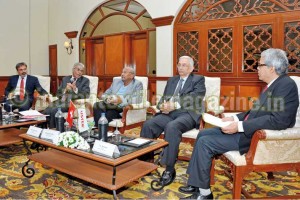
For India’s textile industry, the future is bright indeed. India will ultimately become the world’s biggest cotton producer. However, the quality and value issues will remain if the whole sector is to reach its full potential in the competitive global marketplace.
These were among the major topics highlighted by industry experts and leading figures from the Indian textile industry at the recent three-day event held by USTER QUALITY UNIVERSITY in Goa.
Indian cotton prices are currently among the lowest in the world, lower priced than those of China. Hence yarn and fabric producers might reasonably be expecting an export bonanza. The drawback, however, is that many Indian cotton growers lack the necessary expertise to deliver the raw material quality that spinning mills need. Harvesting, storage and transportation practices all need to be improved, through appropriate education and training.
Attendees at the USTER QUALITY UNIVERSITY heard that the Technology Mission for Cotton (TMC) had a program of actions designed to tackle these challenges. For example, spinning mills wanted to create a fund to educate and train growers in proper transportation and storage of cotton, to minimize contamination.
Spinners and experts from Andhra Pradesh have been calling for improvements in ginning techniques, to produce cottons with lower levels of short fiber, trash and polypropylene contamination. Even gins certified by TMC are said to have been supplying cottons with high short fiber content, caused by unsatisfactory handling in material transfer. The optimized use of pneumatic conveyors at ginning is also being mooted, as a means of reducing the nep content.
These issues were cited as further evidence of the need for a spinner-supported education fund to improve knowledge and practices in ginning.
A special feature of the USTER QUALITY UNIVERSITY was a panel discussion, with leading experts from the cotton sector, organized by Uster Technologies, Switzerland, and the Indian office of this quality measurement and classification instruments manufacturer. The panel comprised Mr. Shashi Stalekar, Vice-President of the Cotton Division of the Ahmedabad-based Sagar Associates, Mr. Manohar Kanitkar, Country Head at US-based Werner International, Mr. G. Punnaiah Choudary, Chairman of the Andhra Pradesh Spinning Mills Association and Honorary President of the Andhra Pradesh Cotton Association, and Mr. Thomas Nasiou, Head of Textile Technology at Uster Technologies.
The panel members agreed that the future is generally bright for Indian textiles, a key factor in this being the difficulties currently being faced by competitors in China. The Chinese Government policies were hampering textile business, both locally and internationally, with the high price of cotton making it hard for China’s spinners to be competitive. And there was no indication when, or if this situation would change.
In the meantime, producers in India, Pakistan and other Asian countries were taking advantage by exporting coarse and medium-count yarns to China at prices which were affordable to customers there but also still profitable for spinners.
Mr. Kanitkar stressed that the best course for the Indian textile sector would be to focus on added-value exports of yarn, fabric and clothing rather than raw cotton. This is despite his view that India is “set to become the biggest producer of cotton in the world.” To foster the required change of emphasis, he suggested that subsidies should be adjusted to target the appropriate segments of the textile value chain.
Total growth along the entire Indian value chain from cotton to finished goods was also forecast by Mr. Choudary who predicted that India would “take the pole position in the worldwide textile sector in the next four to five years. This advance would be heightened by the fact that China is already starting to cut back production of commodity yarns because of rising costs and is likely to also extend this to commodity fabrics at some point.
Optimism for the future of Indian textiles, expressed strongly by Mr. Shashi Stalekar, was underpinned by assistance from a number of State Governments. Spinning mills’ projects such as a recent one in Gujarat would help the goal of adding value to raw cotton, he said.
Trans-Pacific Partnership
A possible counterbalance to the positive impact of Chinese Government actions for Indian spinners is on the horizon, in the form of the Trans-Pacific Partnership (TPP). Many experts see this as bringing disadvantages to the national textile sector.
TPP is a proposed trade agreement under negotiation by Australia, Brunei, Chile, Canada, Japan, Malaysia, Mexico, New Zealand, Peru, Singapore, the US and Vietnam. The idea is to enhance trade and investment, promote innovation, and support job creation and retention.
But it is TPP’s aim of duty-free trade which is seen as putting the Indian industry at a competitive disadvantage. Nevertheless, the potential export benefits continue to attract interest from other countries, including Taiwan, Thailand, the Philippines, Laos, Colombia, Costa Rica, Indonesia, Cambodia and Bangladesh, as well as India itself and even China.
Mr. Thomas Nasiou summed up the benefits of the event by saying: “Our objective with USTER QUALITY UNIVERSITY was to share the experiences and best practices followed by spinning mills from around the globe with top management of Indian spinners, helping them run their spinning operations with a quality mindset, to achieve optimum results both in terms of profitability and quality.”